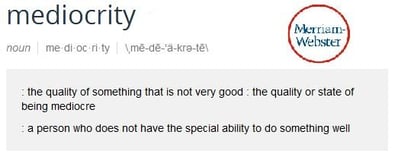Checklist: Is Your Remodeling Business at Risk of Becoming Mediocre?
 As you grow your business day to day management and leadership considerations can quickly creep up on construction business owners. Profitably growing a remodeling business to any volume, but in particular growing past the $1M threshold in produced work, definitely requires advanced business skills. Growing and running your business by the seat of your pants is a sure way to create a mediocre business that will never generate maximum profits. This article offers several ways business owners can determine if they and their businesses are headed for mediocrity. It also offers options to help you and your business get back on track.
As you grow your business day to day management and leadership considerations can quickly creep up on construction business owners. Profitably growing a remodeling business to any volume, but in particular growing past the $1M threshold in produced work, definitely requires advanced business skills. Growing and running your business by the seat of your pants is a sure way to create a mediocre business that will never generate maximum profits. This article offers several ways business owners can determine if they and their businesses are headed for mediocrity. It also offers options to help you and your business get back on track.
Here is a checklist of indicators that your business is becoming mediocre:
- Your business lacks written policies and procedures.
- Even if you have policies you do not have predetermined consequences for violating them and or you do not enforce them.
- You complain about things customers and or employees do or don't do; but then do nothing about them.
- Concerned employees point certain concerning things out and you do nothing to address and or correct things.
- Your employees point things out to you and you actually make them feel guilty for doing so or that they are annoying you by pointing them out.
- Your customers offer feedback or complaints and you make excuses for why things happened, rather than embrace their help and use what they share with you to make improvements or corrections.
- Long term customers stop doing business with you and you don’t bother to ask them why.
- You create artificial harmony by ignoring culture deficiencies and or tension between team members and pretend everything is OK.
- When something happens you always find a way to make it someone else's fault rather than take responsibility as the leader.
If these things are happening at your business you have two options
 The first is to let them keep happening. If you allow things to continue you will likely lose customers, compromise your brand, have high employee turnover and you will never fully achieve creating a successful and profitable business. Eventually, when your family and others ask you why you never really succeeded in business, you will again have to resort to rationalizing why it was someone else's fault.
The first is to let them keep happening. If you allow things to continue you will likely lose customers, compromise your brand, have high employee turnover and you will never fully achieve creating a successful and profitable business. Eventually, when your family and others ask you why you never really succeeded in business, you will again have to resort to rationalizing why it was someone else's fault.
Your other option is to recognize these things are happening and start addressing why they are happening. Only until you know and recognize why they are happening will you be able to work on preventing them from happening.
Preventing these things from happening may require two different solutions
The first is to stop certain things from happening all together by no longer tolerating them. Put your big boy or girl pants on and be the leader you should be. To hold others accountable make sure you create and follow through on consequences.
The other is to change how you do things so they just don't happen anymore. Put policies in place and make sure they are enforced. Those policies should also include clear consequences for violating them.
Lots of remodeling businesses are becoming mediocre as they try to grow in this improving economy. Will you join them or will you stand out from the crowd by becoming the reference standard for what it means to be a professional contractor in your marketplace?



 I came across a great question asked by a group member while participating on LinkedIn. I replied to the question on LinkedIn, but also thought it would make for great info to share with other contractors who might be asking the same question.
I came across a great question asked by a group member while participating on LinkedIn. I replied to the question on LinkedIn, but also thought it would make for great info to share with other contractors who might be asking the same question. Also consider, as a business owner you may personally be measuring your profitability including the costs of any investments for a one year period. As a result may not see a profit in the bank at the end of the year. However the money spent on those investments is still considered profit for business and tax purposes. This is the case because when filing your taxes the government sees these investment type purchases as assets paid for with profits. To get tax deductions for these assets you are allowed to depreciate the assets over time to reduce their value and take tax deductions for them over several years or more. Essentially, for tax purposes, the government measures your profit by combining the money you earned and still have; along with the assets you bought using any profits, as your total taxable net profit. Also, any money your business paid out to you the owner as profit distributions over the year will be considered part of your business’ total taxable net income.
Also consider, as a business owner you may personally be measuring your profitability including the costs of any investments for a one year period. As a result may not see a profit in the bank at the end of the year. However the money spent on those investments is still considered profit for business and tax purposes. This is the case because when filing your taxes the government sees these investment type purchases as assets paid for with profits. To get tax deductions for these assets you are allowed to depreciate the assets over time to reduce their value and take tax deductions for them over several years or more. Essentially, for tax purposes, the government measures your profit by combining the money you earned and still have; along with the assets you bought using any profits, as your total taxable net profit. Also, any money your business paid out to you the owner as profit distributions over the year will be considered part of your business’ total taxable net income. Again, great question to ask. I hope this article helps. Being a business owner means you have to understand how to manage and protect the profits you earn, but at the same time manage how you will be taxed on that same money. By not knowing or ignoring these considerations you can be working hard to make money while profits that could have stayed with you are going out the door to the government as taxes. That said there are a lot of great reasons to have a proactive accountant helping you and your business instead of a historian type accountant who only files your taxes for you when everything is already said and done for the year.
Again, great question to ask. I hope this article helps. Being a business owner means you have to understand how to manage and protect the profits you earn, but at the same time manage how you will be taxed on that same money. By not knowing or ignoring these considerations you can be working hard to make money while profits that could have stayed with you are going out the door to the government as taxes. That said there are a lot of great reasons to have a proactive accountant helping you and your business instead of a historian type accountant who only files your taxes for you when everything is already said and done for the year. Well before attempting to break past $Million in installed sales remodelers and home improvement contractors should already have an established and tested sales system in place. The system should be well defined. Those involved with selling, as well as supporting the sales department at your business, must be trained and held accountable to using it correctly and consistently.
Well before attempting to break past $Million in installed sales remodelers and home improvement contractors should already have an established and tested sales system in place. The system should be well defined. Those involved with selling, as well as supporting the sales department at your business, must be trained and held accountable to using it correctly and consistently.  Decide what Sales System you will use
Decide what Sales System you will use I want to stress that consistency of and with your company's sales approach will be really important as the business grows. Without consistency it will be difficult for the owner to become a sales manager, or transfer sales management to someone else, because each sales person may approach selling in a different way. And, without consistency of sales approach, repeat customers and their referrals may not experience what they expected when a new salesperson visits them. Plus, by having a consistent sales approach that successfully helps prospects buy the right solution, you can market the advantages of that sales system with confidence prospects will experience what they expect if they respond you your marketing.
I want to stress that consistency of and with your company's sales approach will be really important as the business grows. Without consistency it will be difficult for the owner to become a sales manager, or transfer sales management to someone else, because each sales person may approach selling in a different way. And, without consistency of sales approach, repeat customers and their referrals may not experience what they expected when a new salesperson visits them. Plus, by having a consistent sales approach that successfully helps prospects buy the right solution, you can market the advantages of that sales system with confidence prospects will experience what they expect if they respond you your marketing.
 Most remodelers, but certainly not all, rely heavily on referrals and repeat customers as they grow their businesses. This may keep a contractor doing a low volume of work busy, but relying so exclusively on referrals won't be adequate if you want to become a construction business owner, break the $1Million installed sales threshold and develop a constantly growing business.
Most remodelers, but certainly not all, rely heavily on referrals and repeat customers as they grow their businesses. This may keep a contractor doing a low volume of work busy, but relying so exclusively on referrals won't be adequate if you want to become a construction business owner, break the $1Million installed sales threshold and develop a constantly growing business. There are many customer types out there all with their own expectations when it comes to working with a remodeler. Successful remodeling businesses are those that strategically decide who they will be and who they will serve. If you choose to work for people who buy on price and expect more than they are willing to pay for, you will get more work from them. And because people tend to hang out with other people just like them, your past customers will refer you to more customers just like them. Before you do marketing to grow your business decide and define who you want as your customer. Also, think about the project types that make sense for the business you want to develop and grow. For example pull and replace kitchens and bathrooms may not be sexy or all that challenging to you, but remember you are building a company and a team of employees to complete what your company decides to sell. If you decide to build complicated and or highly detailed projects you will need the appropriate systems and staff to estimate, sell and produce that level of project to the expectations of your targeted client type. Choose wisely.
There are many customer types out there all with their own expectations when it comes to working with a remodeler. Successful remodeling businesses are those that strategically decide who they will be and who they will serve. If you choose to work for people who buy on price and expect more than they are willing to pay for, you will get more work from them. And because people tend to hang out with other people just like them, your past customers will refer you to more customers just like them. Before you do marketing to grow your business decide and define who you want as your customer. Also, think about the project types that make sense for the business you want to develop and grow. For example pull and replace kitchens and bathrooms may not be sexy or all that challenging to you, but remember you are building a company and a team of employees to complete what your company decides to sell. If you decide to build complicated and or highly detailed projects you will need the appropriate systems and staff to estimate, sell and produce that level of project to the expectations of your targeted client type. Choose wisely. Your marketing should serve two very important purposes. The first is to help your target customer type(s) find you. The second is to convert leads into sales. The marketing tactics you use should support these two goals. One marketing tactic that can be really effective at accomplishing both could be your company web site. For example, done well, SEO can be used so prospects searching online for certain services and contractor types can find your business, and find it on the first page of search engine results. Goal #1 achieved. But once you get them to your site you also need to differentiate your business from other businesses in the marketplace
Your marketing should serve two very important purposes. The first is to help your target customer type(s) find you. The second is to convert leads into sales. The marketing tactics you use should support these two goals. One marketing tactic that can be really effective at accomplishing both could be your company web site. For example, done well, SEO can be used so prospects searching online for certain services and contractor types can find your business, and find it on the first page of search engine results. Goal #1 achieved. But once you get them to your site you also need to differentiate your business from other businesses in the marketplace  Growing a remodeling business past $1Million a year of installed sales comes with new costs and expenses as the number of employees and overhead related activities naturally increase. Just like estimating the cost of a remodeling project, the business owner will need a practical plan for growing the business and an accurate estimate of the costs related to growing it. Then just like a remodeling project the business needs a way to measure how well things are actually going against the plan and budget.
Growing a remodeling business past $1Million a year of installed sales comes with new costs and expenses as the number of employees and overhead related activities naturally increase. Just like estimating the cost of a remodeling project, the business owner will need a practical plan for growing the business and an accurate estimate of the costs related to growing it. Then just like a remodeling project the business needs a way to measure how well things are actually going against the plan and budget.  As the business grows and more employees are added to share the workload the owner must be able to delegate tasks he or she probably did them self as they grew the business. These delegated activities might include things like product selection, product procurement, production management, and even the responsibility for doing the estimating.
As the business grows and more employees are added to share the workload the owner must be able to delegate tasks he or she probably did them self as they grew the business. These delegated activities might include things like product selection, product procurement, production management, and even the responsibility for doing the estimating.  Without an accurate financial system in place your business will, unfortunately, be like the majority of other remodeling businesses in our industry. Over 80% of remodelers have no idea of the true cost of being in business. These businesses use what is referred to as the WAG method, or "Wild Ass Guess Method” for estimating direct cost and even the markup percentage to use on estimated costs when pricing the jobs they sell. If that describes you and your business put the things I describe here in this article in place at your business before you seek to take-off past $1Million in remodeling. Growing your business should be rewarding and profitable. Entering the unknown without being properly prepared can be costly and may even lead to the demise of your remodeling business.
Without an accurate financial system in place your business will, unfortunately, be like the majority of other remodeling businesses in our industry. Over 80% of remodelers have no idea of the true cost of being in business. These businesses use what is referred to as the WAG method, or "Wild Ass Guess Method” for estimating direct cost and even the markup percentage to use on estimated costs when pricing the jobs they sell. If that describes you and your business put the things I describe here in this article in place at your business before you seek to take-off past $1Million in remodeling. Growing your business should be rewarding and profitable. Entering the unknown without being properly prepared can be costly and may even lead to the demise of your remodeling business. Newton’s Law of Momentum states that “A body in motion tends to stay in motion and tends to continue in the same direction.” Remodelers who downsized their businesses during the recession might want to consider Newton’s law.
Newton’s Law of Momentum states that “A body in motion tends to stay in motion and tends to continue in the same direction.” Remodelers who downsized their businesses during the recession might want to consider Newton’s law.  If you have convinced yourself that your business isn’t really all that bad when you compare it to other dysfunctional businesses that are worse off than yours, yours will never achieve true success. Being less bad is not good. Rather than judge your business on relative success, you should judge it based on absolute success. Again this requires planning, but also requires establishing metrics against which you, and anyone else who reads your plan, can measure whether your plan is working and is actually leading you towards predefined success. Keep in mind that being better off than you used to be might not be a great place to be either. Think of it this way;
If you have convinced yourself that your business isn’t really all that bad when you compare it to other dysfunctional businesses that are worse off than yours, yours will never achieve true success. Being less bad is not good. Rather than judge your business on relative success, you should judge it based on absolute success. Again this requires planning, but also requires establishing metrics against which you, and anyone else who reads your plan, can measure whether your plan is working and is actually leading you towards predefined success. Keep in mind that being better off than you used to be might not be a great place to be either. Think of it this way; There are many remodeling business myths that seem to have become truths for way too many remodelers. That’s too bad. Believing those myths may be holding them back from being able to grow their businesses. Allowing these myths to remain in place will definitely prevent remodelers from successfully growing their businesses past the $1 Million installed sales threshold.
There are many remodeling business myths that seem to have become truths for way too many remodelers. That’s too bad. Believing those myths may be holding them back from being able to grow their businesses. Allowing these myths to remain in place will definitely prevent remodelers from successfully growing their businesses past the $1 Million installed sales threshold. Again, will you jump off the bridge, too? Will Delta Airlines let you pay after you land? Completing remodeling services without being paid for them before you do them is in my opinion foolish, and a huge risk for most remodelers. It instantly creates cash flow challenges in a business where cash is king. Breaking $1M without good cash flow might be the death of your business. Here is how you can create payment schedules that keep you ahead of your customer:
Again, will you jump off the bridge, too? Will Delta Airlines let you pay after you land? Completing remodeling services without being paid for them before you do them is in my opinion foolish, and a huge risk for most remodelers. It instantly creates cash flow challenges in a business where cash is king. Breaking $1M without good cash flow might be the death of your business. Here is how you can create payment schedules that keep you ahead of your customer: 
 Do a business assessment before you commit to changes
Do a business assessment before you commit to changes

 Owners should seek to put a more refined structure in place for the purpose of better, faster, and more accurate information. This is a critical step towards the owner’s ability to evolve away from the micromanagement of employees.
Owners should seek to put a more refined structure in place for the purpose of better, faster, and more accurate information. This is a critical step towards the owner’s ability to evolve away from the micromanagement of employees. Give salespeople the support they need to support sales less on their own, sell more and keep them selling profitably.
Give salespeople the support they need to support sales less on their own, sell more and keep them selling profitably.
 This stage of business growth is what I refer to as the “Take-Off Stage” for a remodeling business because either the business takes off successfully, or it doesn’t. Another way of looking at it might be either the business owner commits to doing it and doing it right, or accepts the status quo of accidental and unplanned growth.
This stage of business growth is what I refer to as the “Take-Off Stage” for a remodeling business because either the business takes off successfully, or it doesn’t. Another way of looking at it might be either the business owner commits to doing it and doing it right, or accepts the status quo of accidental and unplanned growth. Through experience an advanced
Through experience an advanced 





